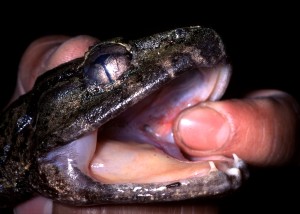
Despite a name that sounds like it came from a bizarre horror film, the fanged frogs of Sulawesi are not particularly dangerous. In fact, the exact function of the fangs – technically bony odontoid processes – isn’t really known. “They could be used for defence, although it’s not clear that that’s true,” says Ben Evans of McMaster University “They certainly don’t bite you when you catch one in your hand.” What Evans does know is that these unusual critters are a perfect example of the evolutionary process of adaptive radiation.
Evans is an evolutionary biologist who has spent years studying the biogeography of the Indonesian island of Sulawesi. “Sulawesi is interesting because it’s near some large islands, but it’s biogeographically very distinct,” he says. “A remarkable and precipitous faunal divide occurs between Sulawesi and Borneo, which is famous in biogeography. It’s called Wallace’s line.” Alfred Russell Wallace, a well-known biologist and contemporary of Charles Darwin, worked extensively in the Indonesian archipelago, using it as a model system to understand the processes that affect biodiversity worldwide.
The reason fanged frogs – genus Limnonectes – are so interesting is that they somehow managed to cross Wallace’s line. In addition to being found all over south and southeast Asia, they exist in great numbers on Sulawesi. Over the course of six major month-long expeditions spanning the last decade, Evans and his intrepid researchers managed to catch 683 of them. It wasn’t always easy. “The larger species tend to congregate around fast-moving water. They’re actually incredibly hard to catch because they jump into the water and swim very fast.” By comparing the physical and genetic characteristics of the frogs they caught to each other and to fanged frogs from other parts of the world, the team was able to measure their diversity.

The results, published in The American Naturalist, were surprising. Sulawesi is home to about 13 distinct species of fanged frog, nine of which are new enough that they don’t yet have formal species names. By comparison, this is about the same number of Limnonectes species that exist in the Philippines, an area of land almost twice as large as Sulawesi. “The diversity is really striking, even to somebody who isn’t a biologist,” says Evans. “In size for example, some species are about 4 cm long as adults, others are 13 or 14 cm.”
The diversity encompasses not only appearance, but lifestyle as well. Most species of fanged frogs live near fast-moving water, but on Sulawesi, Evans also found species more adapted to life on land. “The terrestrial adapted frogs lay their eggs on land, and the parents guard them until they develop more completely and drop into the water. In one instance, we found internal fertilization, where tadpoles actually go through partial development within the body cavity of the female, who then gives birth to free-swimming tadpoles.” These adaptations are even more remarkable considering that Sulawesi has only been above water for about 15 million years, not very long in evolutionary terms.
Adaptive radiation is the rapid evolution of a diverse group of related species from a single ancestor. Classic examples from history include the Darwin’s finches on the Galapagos islands, or the cichlid fishes of Lake Malawi. In both cases, a single species adapted itself to many ecological niches that were filled by other species in their old habitat, but empty in the new one. In the case of fanged frogs, it’s likely that the first species to arrive on Sulawesi were river-dwelling like the ones on the Philippines. Over time, certain groups of these frogs adapted to live farther away from rivers. Their relatives on the mainland could not because other frogs were already occupying those niches.
Evans says that what’s surprising about the adaptive radiation of the Sulawesi fanged frogs is not the speed at which it happened, but its predictability. Many of the adaptations noted in the land-dwelling Limnonectes on Sulawesi are the same ones noted in another unrelated genus – Platymantis – in the Philippines. “I think what it tells us is that there is sort of an ecological landscape that has available plots,” says Evans. “In the case of these frogs, the ecological opportunities were identified and exploited through speciation in a predictable way.” Not every organism arriving in an isolated area is guaranteed to undergo adaptive radiation, but those that do provide a great opportunity to glimpse the mechanisms that drive the creation of new species, including our own.
No comment yet, add your voice below!